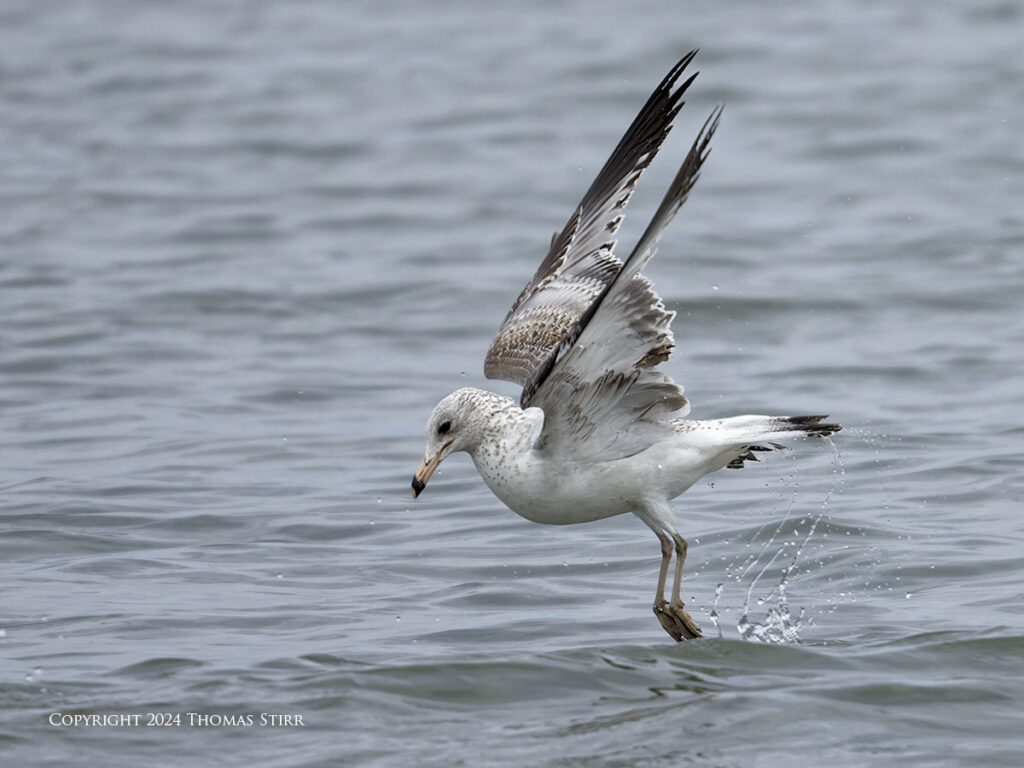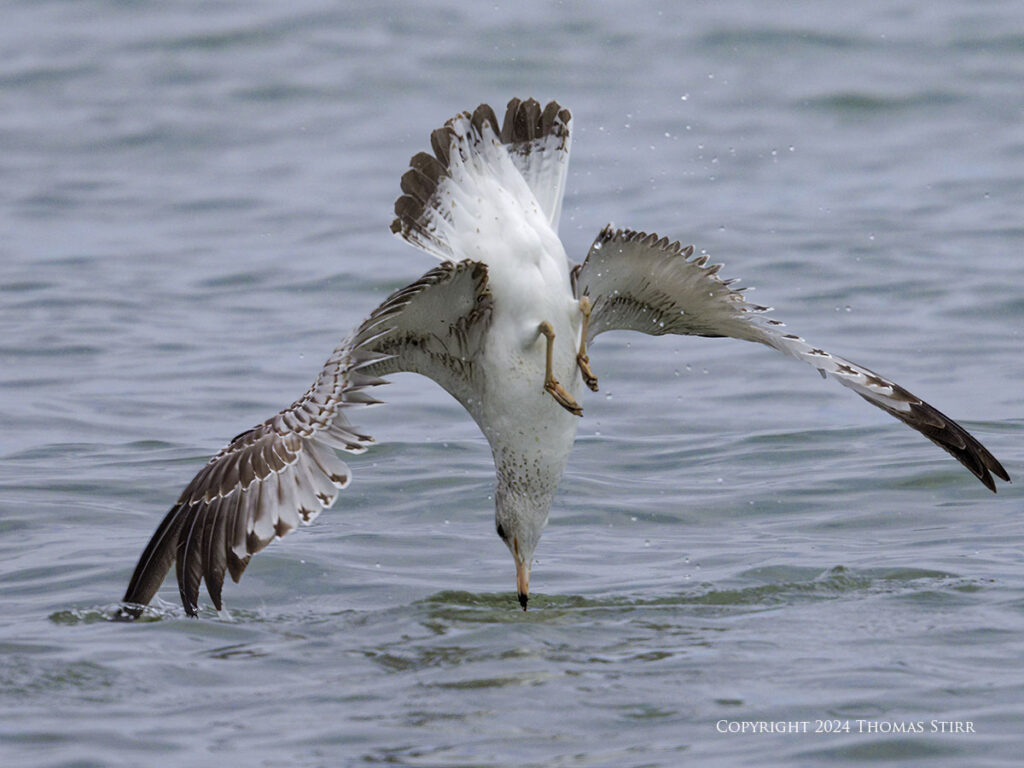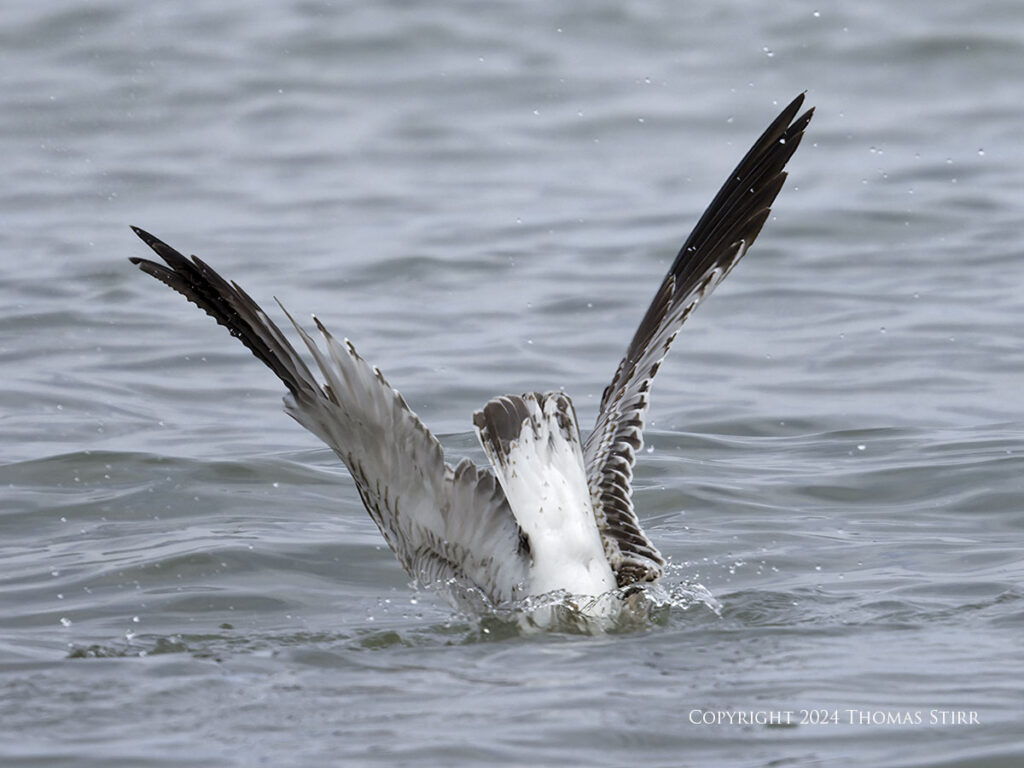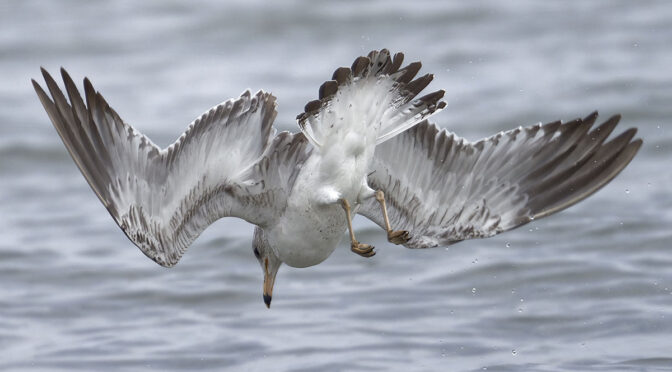Regardless of the camera gear that we may own, timing and technology both play important roles when we’re out in the field with our equipment.
For us to get the most out of our camera gear we need to understand how to best use the technology we’re holding in our hands. And, just as importantly… when to use specific features and capabilities based on our own shooting style and the subject matter before us.
This article shares some new handheld images of gulls at Forty Mile Creek and discusses how these images were captured.
NOTE: Click on images to enlarge.

In terms of the camera gear used, all of the photographs in this article were captured with the M.Zuiko 150-600 mm f/5-6.3 IS zoom along with an OM-D E-M1X. The M.Zuiko 150-600 provides a 50% increase in reach over the M.Zuiko 100-400 with no loss of light.
The benefits of this additional reach were immediately apparent when photographing these subjects that were about 45 metres (~148 feet) away. I was able to put more pixels on my subject birds, and it was much easier to place a single, small AF point accurately on subject birds.
While at Forty Mile Creek I noticed some gulls, each of which were doing a series of surface dives. This is fairly common behaviour. Capturing these rapid surface diving motions while the birds are in mid-air, or hitting the surface of the water, can yield some interesting images. This is where our choice of technology and our sense of timing come into play.

I studied the gulls for a few minutes to try to assess the distances covered by their surface dives… as well as the dive angles that they were using. Observation is always an important part of any photographic session as it really helps to determine the best approach to take for the opportunities at hand.

While many photographers would choose to use a continuous auto-focus setting with their camera for these types of images, I typically use Pro Capture H with my E-M1X.
Using a frame rate of 60 frames-per-second, with a single, small AF point, and the first frame locking focus and exposure for the rest of the run, works very well for me in this type of scenario. When I shot Nikon 1 gear I also often used fast frame rates with the first frame locking focus and exposure.

The caveat is that I need to have adequate depth-of-field… and the subject bird needs to be moving in an appropriate direction for it to stay in focus. If you examine the EXIF data you’ll see that I used a 600 mm (efov 1200 mm) focal length for all of the images featured in this article. My distance to subject varied from about 43 metres to 52 metres (~141 to 171 feet).
If you look at the image above you’ll see that it was captured with a focal length of 600 mm (efov 1200 mm), using an aperture of f/6.3 with the subject distance at 44 metres (~144 feet). These shooting parameters create depth of field of about 1 metre (~3.3 feet) with a M4/3 camera. The gull in the foreground of the image above helps illustrate the depth-of-field in the composition.
If I would have used the M.Zuiko 100-400 mm f/5-6.3 IS lens at 400 mm from the same distance to subject, and at the same aperture… the depth-of-field would have been about 2.3 metres (~7.5 feet). As noted in a number of previous articles on this website… the shorter the focal length… the deeper the depth-of-field will be when compared to a longer focal length shot at the same aperture and distance to subject.
The downside of using the M.Zuiko 100-400 would have been far fewer pixels on the subject bird, and facing a more difficult task to place a single, small AF point accurately on a subject that was much smaller in my EVF.

As photographers we sometimes get fixated with using Continuous Auto-Focus… and we try to use this technology when it isn’t necessary. Or, in some cases when it can actually be counterproductive.

The two photographs above and the one that follows are consecutive captures from the same Pro Capture H image run. My goals with this run was to capture some images of the gull in flight as it was preparing to do a surface dive.

Since I had been observing this specific gull and took note of its body direction I knew it would stay within the depth-of-field I could get when using Pro Capture H.
Shooting an image run with the first frame locking focus and exposure puts less strain on our camera and lens as we are not forcing them to reacquire continuous auto-focus frame by frame. If we’ve done a good job anticipating a subject bird’s direction… and properly place a single, small AF point on it… all of the photographs in the run will be in focus if the first frame is.
So, when could it be counterproductive to use Continuous Auto Focus? Let’s have a look at 10 consecutive images of a gull doing a surface dive. These were captured using Pro Capture H with the first frame locking focus and exposure.










As you can see with the 10 photographs above, there was no logical reason for me to try to use Continuous Auto Focus… when acquiring focus with the first photograph and locking it… was all that was necessary.
As the subject bird disappeared below the surface of the water it creates a risk that a Continuous Auto Focus function may not continue to correctly identify it as a bird… and could result in lost images towards the back end of an image run.

We will sub-optimize our photographic potential if we think that our cameras are slaves to do our bidding. They are our partners in the creative process. Part of our responsibility to our camera gear is to do our best to make it easy for it to perform well for us. That means understanding how to best utilize the technology that is resident in our camera bodies.

The fundamental question is what can we do to make it as easy as possible for our camera gear to create the images we have in our minds? Do we really want to force our cameras to reacquire focus with each and every frame, when single AF could be more than sufficient to do the job?

If we unnecessarily force our cameras to reacquire focus frame by frame… and it misses a few images… where does the blame fall? With our cameras… or with us for not leveraging its technology to best effect?
When we accept responsibility for the photographic results produced… and not blame our camera gear… we put ourselves on a path of creative growth. We also learn the nuances of our camera gear, and how to better partner with it in the future.

Technical Note
Photographs were captured handheld with the camera equipment noted in the EXIF data. All images were created from RAW using my standard process. My standard Pro Capture H settings were used for all of the photographs featured in this article. A frame rate of 60 frames-per-second was used, along with a single, small AF point. My Pre-Shutter Frames and Frame Limiter were both set to 15. This is the 1,373 article published on this website since its original inception in 2015.
How you can help keep this site advertising free
My intent is to keep this photography blog advertising free. If you enjoyed this article and/or my website and would like to support my work, you can purchase an eBook, or make a donation through PayPal. Both are most appreciated.
Sometimes all we need as photographers is a bit of inspiration. We hope you can find some of that inside Finding Visual Expression II.
Finding Visual Expression II is available for download for an investment of $11.99 CDN. The best viewing experience of this eBook will be at 100% using Adobe Acrobat Reader.
You may be interested in all of the 30 concepts covered in both of these related eBooks. If so, you may want to also consider Finding Visual Expression.
Finding Visual Expression is available for download for an investment of $11.99 Cdn. The best viewing experience of this eBook will be at 100% using Adobe Acrobat Reader.
Our other eBooks include Images of Ireland, New Zealand Tip-to-Tip, Nikon 1: The Little Camera That Could, Desert & Mountain Memories, Images of Greece, Nova Scotia Photography Tour, and a business leadership parable… Balancing Eggs.
If you click on the Donate button below you will find that there are three donation options: $7.50, $10.00 and $20.00. All are in Canadian funds. Plus, you can choose a different amount if you want. You can also increase your donation amount to help offset our costs associated with accepting your donation through PayPal. An ongoing, monthly contribution to support our work can also be done through the PayPal Donate button below.
You can make your donation through your PayPal account, or by using a number of credit card options.
Word of mouth is the best form of endorsement. If you like our website please let your friends and associates know about our work. Linking to this site or to specific articles is allowed with proper acknowledgement. Reproducing articles, or any of the images contained in them, on another website or in any social media posting is a Copyright infringement.
Article and images are Copyright 2024 Thomas Stirr. All rights reserved. No use, duplication or adaptation of any kind is allowed without written consent. If you see this article reproduced anywhere else it is an unauthorized and illegal use. Posting comments on offending websites and calling out individuals who steal intellectual property is always appreciated!



